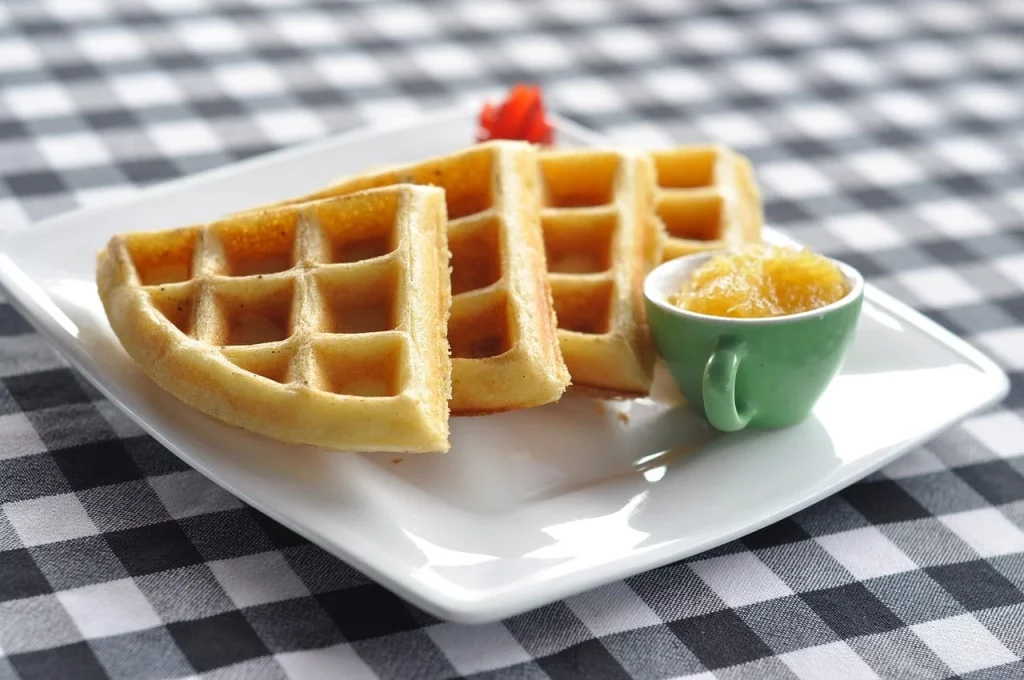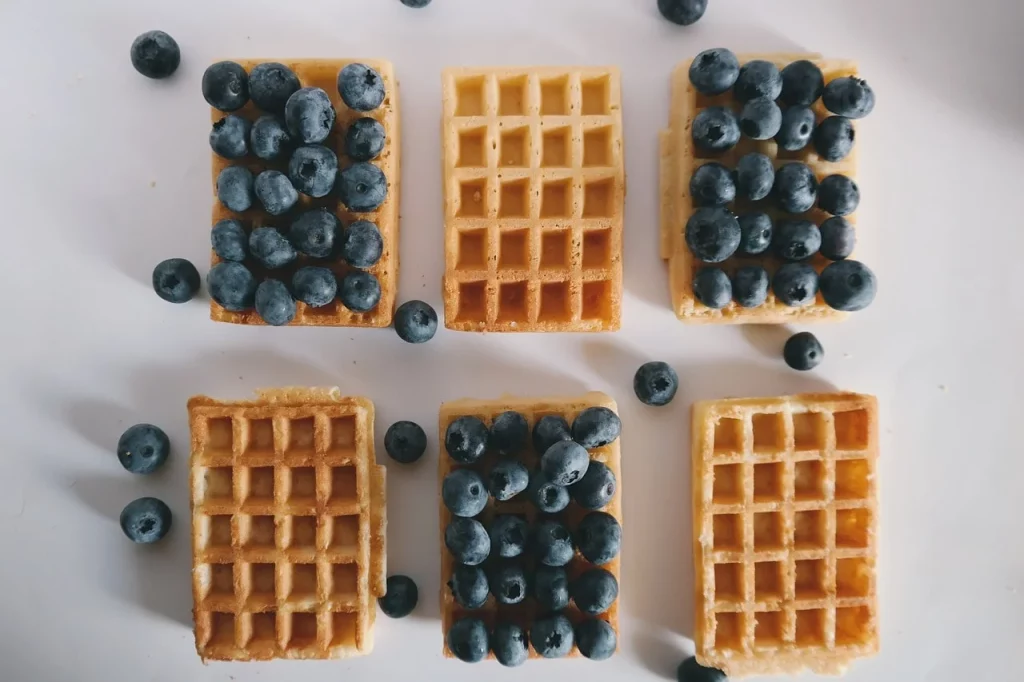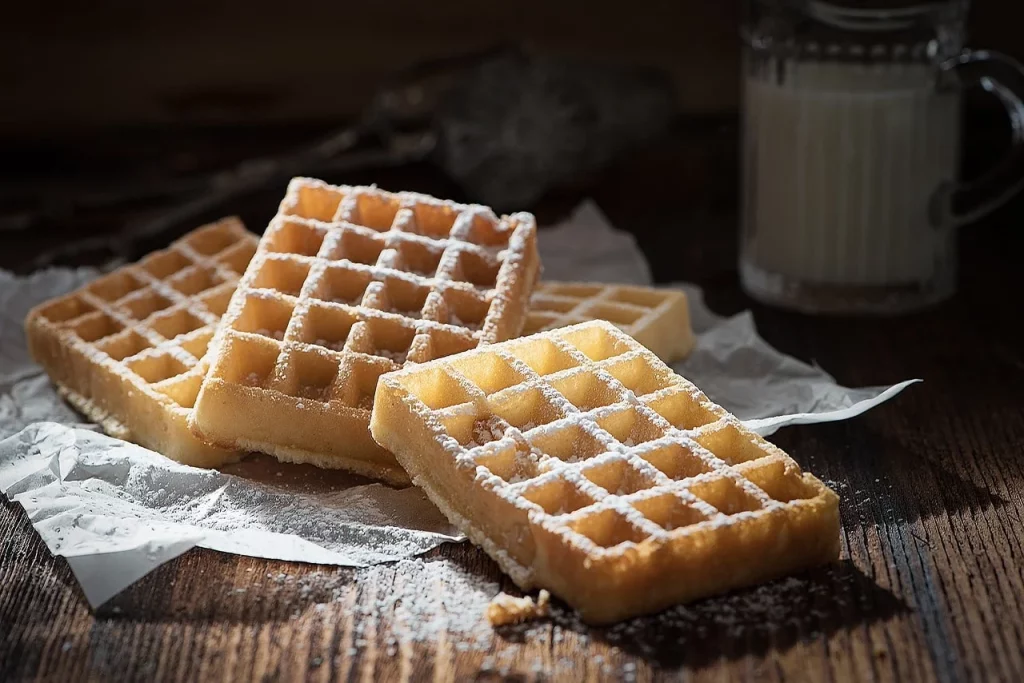Waffles: the ultimate breakfast champion or a dessert genius? Why not both? These delightful treats have been winning hearts with their crispy exterior and fluffy interior, one square at a time.
Whether you’re a fan of the classic buttermilk waffle or you live on the edge with savory options like the pizza waffle, there’s no denying that these culinary masterpieces have a special place in our hearts and plates.
And while some may argue pancakes are the superior breakfast food, let’s be honest: can pancakes hold syrup in each square like a mini bowl? I didn’t think so. So, are you ready to dive into the world of waffles and discover your favorite?
We need to remember what’s important in life: friends, waffles, work. Or waffles, friends, work. Doesn’t matter, but work is third.
Leslie Knope
Waffle Facts
Dive into the world of waffles with me! Read on to uncover fascinating facts, and don’t miss the quiz at the end to show off your expertise.
- The first recorded recipe dates back to the late 14th century and was found in an English manuscript.
- In 1964, Brussels gave the world the beloved Belgian variety at the New York World’s Fair.
- They were initially cooked between two metal plates with wooden handles over an open fire.
- The classic grid pattern was inspired by a honeycomb to distribute heat evenly.
- Thomas Jefferson brought the first iron from France to America, sparking a new culinary trend.
- Every August 24th is celebrated as National Day in the United States.
- The world record for the largest ever made was set in the Netherlands, measuring over 8 feet in diameter.
- Nike’s first pair of running shoes were molded in a waffle iron, leading to the invention of the waffle trainer.
- During the 1600s, they were often sold as street food outside churches in France.
- The phrase “as flat as a” originated in the 17th century, describing someone uninteresting.
- Chicken and waffles originated among the Pennsylvania Dutch in the 1600s as a Sunday dish.
- In Sweden, Waffle Day is a welcome sign of spring, celebrated on March 25th.
- The world’s first dedicated waffle iron for home use was introduced by General Electric in 1911.

- Leggo’s frozen variety was introduced to supermarkets in the 1950s, changing breakfast forever.
- They can be made from alternative flours such as almond, coconut, or even sweet potato for dietary variations.
- Japan’s famous moji are mini versions, often filled with sweet red bean paste.
- In France, a popular street food variation is covered in sugar and sometimes filled with chocolate or fruit.
- The word derives from the Dutch word ‘wafel’, meaning honeycomb.
- Some medieval recipes included wines and cheeses, showing the dish’s versatile nature.
- Liège waffles, another Belgian variety, are distinguished by their pearl sugar that caramelizes on the exterior.
- A common mistake is overmixing the batter, which can lead to tough results.
- The Guinness World Record for the largest stack reached nearly 30 inches tall.
- In Norway, heart-shaped versions are popular, often served with sour cream and jam.
- The introduction of baking powder in the 19th century allowed for fluffier textures.
- They can also be savory, incorporating ingredients like herbs, cheese, and bacon.
- In South Africa, a popular variation is cooked with a yeasted dough for breakfast.
- The first patent for an electric waffle iron was issued in 1911, featuring a built-in thermostat.
- Some of the most luxurious versions include edible gold leaf and champagne cream.

- Portland, Oregon, hosts an annual festival dedicated entirely to celebrating this versatile dish.
- During the 18th century, they were considered a symbol of status and wealth in Europe.
- A traditional Swedish recipe calls for saffron, adding a unique flavor and color.
- Stroopwafels, a Dutch version, are two thin layers with a syrup filling, invented in Gouda in the 18th century.
- In the US, frozen varieties outsell fresh, with millions consumed each year.
- The invention of the rotary iron allowed for even cooking and easier flipping.
- They have been featured in numerous films and TV shows as a comfort food symbol.
- A rare version from Hong Kong is bubble-shaped, creating a unique texture.
- Some artisanal chefs use them as a base for gourmet dishes, topping them with foie gras or caviar.
- The largest ever eating contest involved over 50 contestants and hundreds of servings.

- In the 1920s, they were often served with molasses and pork as a hearty meal.
- A Belgian chef created a luxurious version priced at $1,000, featuring gold dust and caviar.
- Vegan options often substitute eggs and milk with banana and almond milk for a similar texture.
- Some cultures enjoy them as a dessert, topped with ice cream, whipped cream, and fruit.
- A traditional recipe from the American South includes cornmeal for added texture and flavor.
- They were used as a base for ice cream sandwiches in several trendy dessert shops.
- In certain regions, they are traditionally served during weddings and celebrations.
- A savory Japanese version includes octopus and green onions, showing the dish’s adaptability to local tastes.
- Health-conscious versions may include chia seeds and flaxseed for added nutrients.
- During the Renaissance, they were often flavored with rose water and sherry.
- Their shape and pattern have inspired fashion and design, including fabric patterns and jewelry.
- Experimenting with the batter can result in colorful variations, using food coloring or natural ingredients like beet juice.
Waffle Myths

As we transition from the crispy edges of waffle facts, let’s separate truth from myth. The upcoming section aims to dispel any misconceptions and bring clarity to the beloved breakfast dish.
- Waffles Originated in Belgium
Contrary to popular belief, the origins of waffles can be traced back to the Middle Ages in Greece, where flat cakes were cooked between two metal plates. Belgium popularized the waffle, but it was not its birthplace. - Waffles Are Only Served for Breakfast
While commonly enjoyed as a breakfast item, they are incredibly versatile and can be adapted for any meal of the day. They can be topped or filled with a variety of ingredients, making them perfect for lunch, dinner, or dessert. - All Waffles Are the Same
There’s a wide variety of waffles, each with its own unique texture and flavor. From the light and crispy Belgian waffle to the denser Liege waffle and even the softer American-style waffle, diversity is abundant in their world. - Waffles Are Unhealthy
While they can be high in sugars and carbs, the nutritional content greatly depends on the ingredients used. Whole grain, oatmeal, or almond flour can be utilized for healthier options, and toppings can include fruits, nuts, and yogurt to boost nutritional value. - Making Waffles Is Time-Consuming and Difficult
They can be quite easy to prepare, especially with the convenience of modern waffle makers. With simple ingredients and a bit of mixing, delicious waffles can be made quickly. Pre-made mixes also offer a faster, foolproof option for waffle-making enthusiasts.
No products found.
Waffle Quotes

As author Mary Pope Osborne eloquently states, “Waffles are like smiles. They make happy faces.” Let’s delve into some of the words of those who have captured their essence.
Waffles are just awesome bread.
John Green
John Green, an acclaimed author, simplifies the essence of waffles with his characteristic wit, likening them to a superior form of bread.
There are two kinds of people in the world: waffle people and pancake people. And it’s almost impossible to convert one to the other.
Stephen Dubner
Stephen Dubner, co-author of “Freakonomics,” playfully categorizes people by their breakfast preferences, highlighting the deep divide between waffle and pancake lovers.
My wife cooks. I can’t cook. I can remix ingredients very well, but I’m not a cook. You know what I’m good at? I’m very good with waffles. Very good with waffles.
Questlove
Questlove, a musician and producer, confesses his culinary skills are limited, but he excels in making waffles, showcasing his humorous humility.
Life is too short to wonder where you hid your waffle maker.
Paula Deen
Paula Deen, a celebrity chef known for her Southern cooking, humorously suggests that one should always keep the joys of life, like making waffles, within easy reach.
I’m not sure if I was the first to ever make waffles with it, but I definitely didn’t invent the waffle iron.
Maurice Vermersch
Maurice Vermersch, credited with popularizing Belgian waffles in America, humorously remarks on his innovation in waffle making, distinguishing his culinary creativity from the invention of the waffle iron itself.
Waffle FAQ

Before you dive into the trivia, the FAQ section below addresses some common questions about waffles. Read on to ensure you’re fully prepared for the quiz ahead.
- Are waffle and pancake batters the same?
Not quite! While both batters share some ingredients like flour, eggs, and milk, waffle batter typically has more sugar and fat. This gives waffles their characteristic crispy exterior and fluffy inside, compared to pancakes’ soft texture. - Who invented waffle fries?
The specific inventor is a bit of a mystery, as it seems to be a culinary innovation rather than a patented invention. However, they’ve been a popular choice in restaurants and frozen food aisles for decades, celebrated for their unique shape and extra crispy edges. - Are waffle cones gluten-free?
Traditionally, no, as they’re made from a batter containing wheat flour. However, due to growing dietary restrictions and preferences, many places now offer gluten-free waffle cones made with alternative flours, so those avoiding gluten can still enjoy a classic cone. - Can waffles be made without a waffle iron?
Absolutely! While you won’t get the classic grid pattern, you can pour your batter into a greased, hot pan just like a pancake or use a silicone waffle mold in the oven. Creativity is key! - Why do waffles have holes?
Those iconic holes, or pockets, are created by the steam during cooking. They serve a brilliant purpose: holding onto your favorite toppings, from syrup to butter, ensuring every bite is as tasty as can be.
No products found.
Waffle Trivia

Welcome to the ultimate waffle quiz, where the stakes are as high as a stack of Belgian waffles! Fail to answer correctly, and you’ll be doomed to a breakfast of plain oatmeal forevermore.
Conclusion
Waffles aren’t just food; they’re an experience. With their unique ability to be both a sweet treat and a savory meal, they’ve captured our imaginations and taste buds.
As we’ve seen, their history is as rich and textured as their surface, filled with holes perfect for capturing syrup or butter. They encourage us to experiment and find joy in the kitchen, making every meal a potential adventure.
So, cherish your next waffle meal, and remember, the possibilities are endless. Till next time, stay curious. Cheers.


